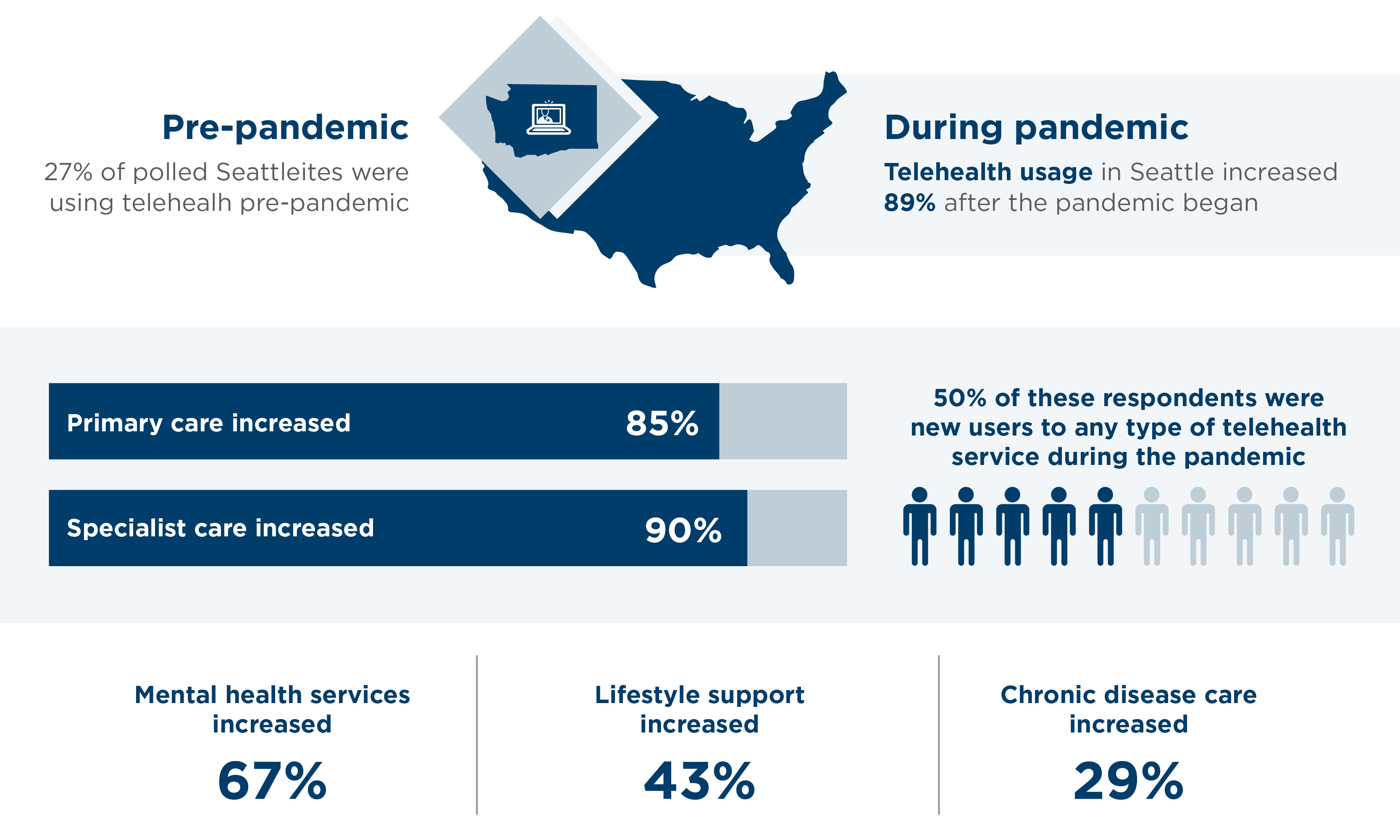
Oct. 15, 2020 | InBrief
Telehealth and the future of healthcare in Seattle
Our new survey of Seattle residents suggests that virtual healthcare could be part of the solution as people continue leaving major cities
Telehealth and the future of healthcare in Seattle
According to an American Hospital Association study, health systems are expected to lose more than $200 billion from cancelled services due to shifts in priorities stemming from the pandemic. Providers, payers, and those who exist in between are fighting the pandemic while also fighting for their businesses.
Unsurprisingly, the information West Monroe recently collected in its latest poll of 1,500 citizens—including 500 in Seattle—validated that telehealth has arrived and is here to say. Even before the pandemic, Seattle consumers reported that they were more likely to consider and use telehealth services. When asked again in September, their willingness to try and use telehealth services across multiple services types had only increased.
This represents a clear opportunity for investment in digital health strategies that immediately tie back to the bottom line. Pivoting to such a strategy will allow organizations to:
Recoup revenue
Elective procedure clinics were hit hard. Efficient and safe ways to provide these services sooner than later – and, just as important, pre- and post-op calls able to be done virtually – will help jumpstart their revenue engine and bring back those who may have been skeptical of returning in-person.
Maximize revenue
Cutting down on office logistics means an opportunity for operational efficiency. Identify areas where telehealth provides efficiencies and capitalize to build better relationships with your patients while also maximizing procedural efficiencies where possible.
Expand revenue
Be a first mover to expand your patient experience outside of the clinic to retain your current consumers. Beyond retaining customers, early movers who provide excellent care with a matching experience to historically underserved populations can also earn a lion’s share of an untapped market.
This healthcare consumer data supports a need to invest in the digital patient experience to keep providers protected from an uncertain future. Healthcare organizations can benefit from this challenge if they are able to adapt to a digital health delivery that provides the kind of customer experience their patients are looking for.
Seattle’s healthcare community is eager and willing to innovate. Washington was one of the first U.S. areas affected by the pandemic, and it stands to reason that they could be on the front-end of virtual care’s evolution.
The unique technology community that exists around Puget Sound will bolster this innovation, but it’s up to healthcare providers to strategize and execute with the right partners.
The approach is the first step, but defining key areas and answering questions within them will help set up long-term success:
Business strategy
Is this a “bolt-on” or “build-on” technology? Is it a core business driver or simply an add-on service? Whether you’re a provider organization or health system, knowing how virtual care capabilities will fit into (and potentially change) core aspects of your business is essential to the success of your initiative. Depending on needs, strategy, or budget, you may elect to focus your virtual care efforts on specific lines of business or services in order to zero in on specific KPIs or success measures. Or you may choose to take a more comprehensive approach.
Provider engagement
How will a solution improve provider relationships and clinical outcomes? You’ll want to consider the extent to which virtual care will complement existing workflows and improve productivity—the idea is to make things easier on your organization and your providers by thinking creatively about how any new tools and processes can positively impact the day-to-day.
Patient engagement
How can virtual care services improve access, timeliness, and value? Patient engagement is key, of course, and your virtual care capabilities must provide a consistent, convenient experience that’s sustainable and integrated into their overall care journeys. The last thing you want is to create a sense of fragmentation or uncertainty or create barriers to access.
Bottom line impact
How will virtual care grow revenue and market share? What cost containment and utilization management opportunities will these service channels present? It’s important to build a revenue model around your virtual care services that supports their continued growth over time with a pay-it-forward mentality. Yes, you want to maintain continuities of care, provide different access points for patients, engage your clinicians, and differentiate yourself in the market. The way to do that immediately and in the longer term is to plan to consistently build upon the foundation you’ve established (or are planning to establish) by leaning on the experience and cost savings generated now to propel future expansions.
As telemedicine continues to gain relevance in the healthcare space, our West Monroe team will expand on this and provide our insights, perspectives, and analysis on virtual health.



